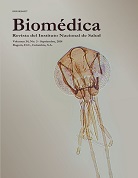Evaluation of lethal ovitraps as a strategy for Aedes aegypti control
Abstract
Introduction: Dengue fever is a vector-borne viral disease of major public health importance. In the absence of a vaccine, control measures are primarily focused on reducing the mosquito vector. However, these strategies are very expensive, and the use of lethal ovitraps could contribute, in a practical manner, to the design of cost-effective strategies for vector control.
Objective: To determine the most efficient type of lethal ovitrap for Ae. aegypti vector control by combining different types of insecticides, oviposition substrates and attractant infusions.
Materials and methods: The study was conducted in two stages. In the first, 18 different ovitraps resulting from the combination of insecticides (deltamethrin and permethrin), oviposition substrates (towel, dacron and flannel), and attractant infusion (10 and 20% hay infusion, and dechlorinated water) were evaluated in the laboratory. For this evaluation, ovitraps were placed into a mosquito holding cage, and 100 gravid Ae. aegypti females were released. The top six ovitraps were selected based on the higher number of registered eggs, and the lower hatched eggs percentage. In the second, the top six ovitraps were evaluated in field conditions.
Results: In laboratory conditions, statistical differences were observed between the 18 ovitraps. The ovitraps with deltamethrin were the most efficient showing the best results. In field conditions, the ovitraps with the highest vector reduction were those combining deltamethrin/towel/10% hay infusion.
Conclusions: The ovitrap combining deltamethrin, towel as oviposition substrate, and 10% hay infusion as attractant was the most efficient Ae. aegypti vector control.
Downloads
Some similar items:
- Clara Beatriz Ocampo, Camila González, Carlos A. Morales, Mauricio Pérez, Dawn Wesson, Charles S. Apperson, Evaluation of community-based strategies for Aedes aegypti control inside houses , Biomedica: Vol. 29 No. 2 (2009)
- Larry Niño, Use of the function semivariogram and kriging estimation in the spacial analysis of Aedes aegypti (Diptera: Culicidae) distributions , Biomedica: Vol. 28 No. 4 (2008)
- Ronald Maestre, Consuelo Vergara Sanchez, Guillermo Berrueco Rodríguez, Betsy Bello Novoa, Helena Brochero, Presence of Haemagogus equinus Theobald, 1903 (Diptera: Culicidae), in Soledad and Malambo, in the Province of Atlántico, Colombia , Biomedica: Vol. 28 No. 1 (2008)
- Claudia M.E. Romero, Humberto Llinás, Andrew K.I. Falconar, Evaluation of a rapid water-surface sweeping method to curately estimate numbers of Aedes aegypti (Diptera: Culicidae) late larval stages in large water-storage containers: comparison with pupal estimates , Biomedica: Vol. 30 No. 2 (2010)
- Susanne Ardila-Roldán, Liliana Santacoloma, Helena Brochero, Status of insecticide susceptibility of public health use in natural populations of Aedes aegypti (Diptera: Culicidae) of Casanare, Colombia , Biomedica: Vol. 33 No. 3 (2013)
- César A. Rodriguez, Diana C. Gallego, José A. González, Paola A. Luna, Mitzilene Navarro, Germán A. Ramírez, Mosquitoe breeding sites and fauna ln Armenia's urban area aiier the January 25, 1999, earthquake , Biomedica: Vol. 21 No. 2 (2001)
- Ariosto Ardila, Jesús Escovar, Felio Bello, Characteristics of new cell cultures derived from embryonic tissues of Aedes aegypti (Diptera: Culicidae). , Biomedica: Vol. 25 No. 1 (2005)
- Érika Patricia Alarcón, Ángela María Segura, Guillermo Rúa-Uribe, Gabriel Parra-Henao, Ovitraps evaluation for surveillance and control of Aedes aegypti in two urban settlements of Urabá, Antioquia , Biomedica: Vol. 34 No. 3 (2014)
- Jorge Mario Cadavid, Guillermo Rúa, Omer Campo, Gabriel Bedoya, Winston Rojas, Microgeographic and temporal genetic changes of Aedes aegypti from Medellín, Colombia , Biomedica: Vol. 35 No. 1 (2015)
- Lucas Alcalá, Juliana Quintero, Catalina González-Uribe, Helena Brochero, Estimation of Aedes aegypti (L.) (Diptera: Culicidae) productivity in households and public spaces in a dengue endemic city in Colombia , Biomedica: Vol. 35 No. 2 (2015)
| Article metrics | |
|---|---|
| Abstract views | |
| Galley vies | |
| PDF Views | |
| HTML views | |
| Other views | |


























